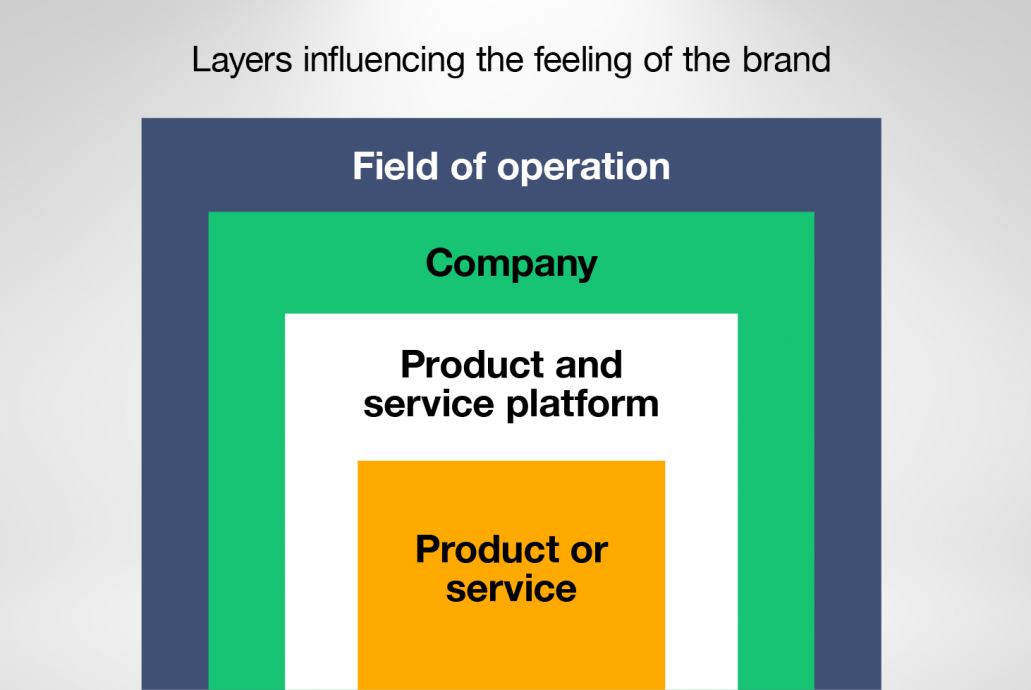Design is not only how something looks and works, but also how it makes you feel
Service design helps to create a feeling about a specific company.
Why does someone prefer your company to your competitors? We make purchasing decision based on our emotions and only later start thinking about it more and adding in the rationale behind that decision. So, the reason why someone prefers one thing over another is based on that particular person’s feelings. We could say that their feeling is your brand.
Although all of the activities you do – and not just brand strategy and visual materials – affect that feeling, then it is not possible to fully control people’s minds and thus, no one can have complete control over their brand either.
Some interesting facts:
- We make 90% of our decisions based on our emotions and we add rational explanations to them later (Damasio, 2005)
- 95% of purchasing decisions are made subconsciously (Zaltman, 2003)
- Up to 93% of the communication that conveys a message is non-verbal (Mehrabian, 1981
Based on the above, we can say that 90% of a brand is emotion. The brand is the compnay’s image or in other words, the manner in which a client perceives a company. Our decisions are based on emotions which are created in our subconscious and in large part, as a result of non-verbal communication.
That means that a brand is a sentiment – the good and bad things someone is feeling towards you as well as thinking and saying about you; the things that the user loves and those they are irritated by.
When designing your brand, the logo and colour combination are just as important as the mission and vision stated in the company’s strategy. Leading that brand will be difficult while those words remain on the paper and have not been implemented in the company’s everyday work routines on every level.
Any gaps and inconsistencies that appear as a result may affect the user’s perception without them ever consciously recognising the change or being able to put it into words.
The company’s blind spots can be found between products and services
One vivid example of such a gap was given by the Finland-born speaker and consultant Tuija Seipell. Because of her work, she spends about four months a year in hotels. Hotels always advertise a comfortable and carefree experience to their customers. All of their activities and amenities, such as spas, top-level restaurants, room service etc, which all support a pleasant stay are devoted to the customers.
But for some reason, a part of that carefree experience is always the fact that the hotel customers come into contact with cleaning carts in the hallways which are filled with dirty linen, cleaning supplies and drying rags.
Those carts then take up space in the hallways where they await you both during the day and night, when you leave your room and when you come back, creating an unavoidable inconsistency between the luxury you have been promised and reality.
When you invite people over to your home, it is unthinkable that you would have the hoover lying around in the hallway, wet rags drying in the kitchen, or dirty linen piled up on your couch. Then why is it acceptable in an environment where the customer has paid to feel carefree?

Cleaning trolley in the hotel corridor. Photo author Helen Susan Selirand, 2020
Cleaning carts are one of the blind spots in the customer experience offered by hotels. It is one of the most efficient and time-saving ways for the cleaning staff to clean up the rooms, but by option for this solution, the company also sacrifices their promise to their guests. A comfortable carefree experience.
Gaps and inconsistencies in customer experience are not rare. A company’s cleaning cart could be hidden on the company’s website, in the furnishings of their flagship store, or in the tone of voice of the receptionist who answers the information line.
After a pleasant conversation with a customer service representative in-store – which created trust and a feeling of comfort in the customer –, the customer was sent home to delve more deeply into the services offered on the company’s website.
But it turned out that the website was built in a way that was confusing for the customer, which then made them feel frustrated. Although the customer service representative who would have answered the call to customer support may be very friendly and helpful, the long wait time on the phone made the customer feel like the company does not value their time.
It is very important to understand the reasons behind a customer’s decisions and behaviour to identify gaps and inconsistencies. The age of information has provided us with the opportunity to track user behaviour when using digital products and services, which in turn helps to make those products and services better and to keep developing them, based on the feedback the customer provides. But unfortunately, data-based insights do not reveal to us the reasons why customers make decisions one way or another.
Even if we use surveys and feedback forms, we cannot determine how the customer was feeling when they made their decision or which factor that has gone unnoticed by the company itself actually affected that decision.
As mentioned earlier, we make a lot of our feelings-based decisions unconsciously but start to rationalise them later on and creating reasons for them without really noticing what really had an impact on that decision.
Service design helps to see the whole system
Service design looks at systems as a whole, not based on just one product or service. The user journey contains a lot of connected parts that affect their experience and feel.
Service design methods are irreplaceable in understanding customers and users as they enable us to determine what motivates users and what their actual desires and needs are via observation, qualitative research, identifying analogues in other areas, and synthesising all of the data gathered.
Through all this, it is possible to reveal current blind spots as well as future opportunities for services, products, and the company. Service design makes it possible to create services and products that form a whole and ensure a consistent emotion and feel for the brand throughout the user journey.

Layers influencing the feeling of the brand
Through service design, Trinidad Wiseman has created new value for companies such as Tallink, Pärnu Hospital, and Elisa. Service design is an inclusive process that encompasses various different methods and that clients, employees as well as the management can all participate in.
The first important step is gathering qualitative data about the current service experience, which is done via interviews, observations and workshops. This allows to map out the whole customer journey by bringing out the strengths, weaknesses, and new growth opportunities found within each touchpoint.
Through this kind of mapping, it is possible to find new connections between customer behaviour and the essence of the service and to give them a clear wording. As a result of this research, the problem will be defined together with the representatives of the company and following that, everyone will start working together on finding a solution for that problem.
To ensure success, all goals will be described as clearly as possible and the criteria for evaluating those goals will be set. From here, we can start generating new ideas to execute and test, whether those ideas involve service, product, or brand strategy.
Creating a successful brand strategy determines how the whole company is structured and performs. A brand is not just the part the customer can see – e.g., marketing materials and a website – but also the things they cannot see.
Non-verbal communication and unconscious experience are direct and honest and affects people much more than the things they have been knowingly directed towards and then spoon-fed.
All of the above enables us to get closer to understanding our client and their actual needs step-by-step. Many companies try to answer the question “What is now?” when making decisions, thus focusing on the things that already exist and that can be created with currently existing resources. But that question creates strong boundaries and only allows for small changes that have a small impact.
By knowing your client and asking “What if?” instead, you open up the way for new opportunities and we can start really dreaming about the future. In this case, the decisions are not so much based on what already exists, but on what the client and user actually wish to achieve and feel. Curiosity and discovery help guide the process and bring forth the issues that actually need to be resolved.
A thought experiment
To finish, here is one thought experiment to refresh your memory.
Are you the average customer of your company? A true, average person from the street with no privileges and no way of immediately contacting “the right person” to help resolve your problems. Stepping into the customer’s shoes is the first step towards becoming your company’s average customer.
Instead of asking a colleague directly, this will help you understand how the average customer feels when calling customer support or navigating around the company’s website to try and find a solution for service issues they encounter. In this way, you can gai direct, purely emotion-based feedback about your company and start thinking about the “What if?” questions that will help you create complete strategies.
References
Damasio, A. R. (2005). Descartes’ error: Emotion, reason, and the human brain (Reprint edition). Penguin Books.
Zaltman, G. (2003). How customers think: Essential insights into the mind of the market (Illustrated edition). Harvard Business School Press.
Mehrabian, A. (1981). Silent messages: Implicit communication of emotions and attitudes (2nd ed.). Belmont, CA: Wadsworth.







